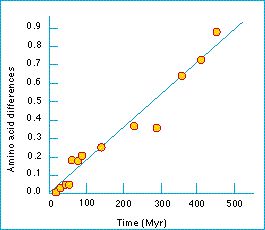Molecular evolution and neutral theory - What were Kimura's arguments for neutralism?

Kimura's first argument
The first argument put forward by Kimura is that the observed rate of evolution is too high for evolution by natural selection, but not for neutral drift.
• High rates of molecular evolution
When the earliest measurements of rates of molecular evolution became available, Kimura noticed that they implied much higher rates of change than Haldane's estimate of the maximum rate of evolution by natural selection, i.e. one substitution per 300 generations. Kimura estimated that there was one change in the genome every two or three years. This is shown by the figure illustrating the rate of change of hemoglobin. That is more than 100 times as fast as Haldane's upper limit.
• Neutralism can account for this rate
If Haldane's argument is correct, natural selection could not drive evolution as fast as it has been occurring in proteins: if natural selection operated that hard on a population, everyone in it would be dead before long. From this, Kimura concluded that natural selection could not account for the majority of molecular evolutionary change.
With neutral drift, no difficulty arises. There is no cost of substituting one allele for another by random drift. Evolution by random drift is as rapid as the rate at which neutral mutations arise. That rate is unknown. And because it is unknown, the neutral theory can hypothetically explain almost any observed rates of evolution.
The rate of evolution of hemoglobin. Each point on the graph is for a pair of species, or group of species. Some of the points are for a-hemoglobin, others for B-hemoglobin. From Kimura (1983).
| Next |



